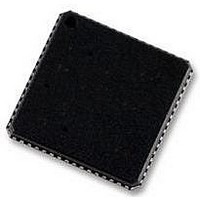ADSP-BF592KCPZ Analog Devices Inc, ADSP-BF592KCPZ Datasheet - Page 3

ADSP-BF592KCPZ
Manufacturer Part Number
ADSP-BF592KCPZ
Description
58T4522
Manufacturer
Analog Devices Inc
Specifications of ADSP-BF592KCPZ
Operating Temperature (min)
0C
Operating Temperature (max)
70C
Operating Temperature Classification
Commercial
Mounting
Surface Mount
Pin Count
64
Rohs Compliant
YES
Frequency
400MHz
Embedded Interface Type
PPI, SPI, UART
No. Of I/o's
32
Operating Temperature Range
0°C To +70°C
Digital Ic Case Style
LFCSP
No. Of Pins
64
Core Supply Voltage
1.4V
Lead Free Status / RoHS Status
Compliant
Available stocks
Company
Part Number
Manufacturer
Quantity
Price
Company:
Part Number:
ADSP-BF592KCPZ-2
Manufacturer:
BROADCOM
Quantity:
154
GENERAL DESCRIPTION
The ADSP-BF592 processor is a member of the Blackfin
of products, incorporating the Analog Devices/Intel Micro
Signal Architecture (MSA). Blackfin processors combine a dual-
MAC state-of-the-art signal processing engine, the advantages
of a clean, orthogonal RISC-like microprocessor instruction set,
and single-instruction, multiple-data (SIMD) multimedia capa-
bilities into a single instruction-set architecture.
The ADSP-BF592 processor is completely code compatible with
other Blackfin processors. The ADSP-BF592 processor offers
performance up to 400 MHz and reduced static power con-
sumption. The processor features are shown in
Table 1. Processor Features
1
By integrating a rich set of industry-leading system peripherals
and memory, Blackfin processors are the platform of choice for
next-generation applications that require RISC-like program-
mability, multimedia support, and leading-edge signal
processing in one integrated package.
PORTABLE LOW POWER ARCHITECTURE
Blackfin processors provide world-class power management
and performance. They are produced with a low power and low
voltage design methodology and feature on-chip dynamic
power management, which provides the ability to vary both the
voltage and frequency of operation to significantly lower overall
power consumption. This capability can result in a substantial
reduction in power consumption, compared with just varying
the frequency of operation. This allows longer battery life for
portable appliances.
head looping. The architecture is fully interlocked, meaning that
the programmer need not manage the pipeline when executing
Feature
Timer/Counters with PWM
SPORTs
SPIs
UART
Parallel Peripheral Interface
TWI
GPIOs
Maximum Instruction Rate
Maximum System Clock Speed
Package Options
Maximum instruction rate is not available with every possible SCLK selection.
L1 Instruction SRAM
L1 Instruction ROM
L1 Data SRAM
L1 Scratchpad SRAM
L3 Boot ROM
1
64-Lead LFCSP
ADSP-BF592
100 MHz
400 MHz
Table
32K
64K
32K
4K
4K
32
3
2
2
1
1
1
Rev. A | Page 3 of 44 | August 2011
1.
®
family
SYSTEM INTEGRATION
The ADSP-BF592 processor is a highly integrated system-on-a-
chip solution for the next generation of digital communication
and consumer multimedia applications. By combining industry
standard interfaces with a high performance signal processing
core, cost-effective applications can be developed quickly, with-
out the need for costly external components. The system
peripherals include a watchdog timer; three 32-bit timers/coun-
ters with PWM support; two dual-channel, full-duplex
synchronous serial ports (SPORTs); two serial peripheral inter-
face (SPI) compatible ports; one UART
parallel peripheral interface (PPI); and a 2-wire interface (TWI)
controller.
BLACKFIN PROCESSOR CORE
As shown in
16-bit multipliers, two 40-bit accumulators, two 40-bit ALUs,
four video ALUs, and a 40-bit shifter. The computation units
process 8-, 16-, or 32-bit data from the register file.
The compute register file contains eight 32-bit registers. When
performing compute operations on 16-bit operand data, the
register file operates as 16 independent 16-bit registers. All
operands for compute operations come from the multiported
register file and instruction constant fields.
Each MAC can perform a 16-bit by 16-bit multiply in each
cycle, accumulating the results into the 40-bit accumulators.
Signed and unsigned formats, rounding, and saturation
are supported.
The ALUs perform a traditional set of arithmetic and logical
operations on 16-bit or 32-bit data. In addition, many special
instructions are included to accelerate various signal processing
tasks. These include bit operations such as field extract and pop-
ulation count, modulo 2
and rounding, and sign/exponent detection. The set of video
instructions includes byte alignment and packing operations,
16-bit and 8-bit adds with clipping, 8-bit average operations,
and 8-bit subtract/absolute value/accumulate (SAA) operations.
The compare/select and vector search instructions are also
provided.
For certain instructions, two 16-bit ALU operations can be per-
formed simultaneously on register pairs (a 16-bit high half and
16-bit low half of a compute register). If the second ALU is used,
quad 16-bit operations are possible.
The 40-bit shifter can perform shifts and rotates and is used to
support normalization, field extract, and field deposit
instructions.
The program sequencer controls the flow of instruction execu-
tion, including instruction alignment and decoding. For
program flow control, the sequencer supports PC relative and
indirect conditional jumps (with static branch prediction) and
subroutine calls. Hardware is provided to support zero over
instructions with data dependencies.
Figure
2, the Blackfin processor core contains two
32
multiply, divide primitives, saturation
®
with IrDA support; a
ADSP-BF592














